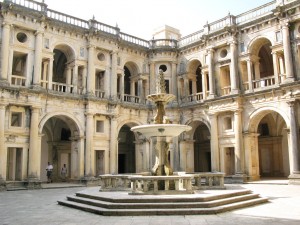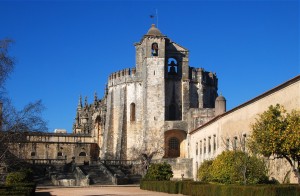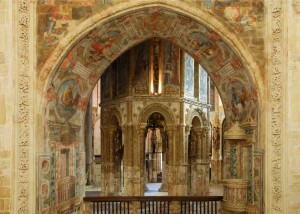 “Maybe we just heard someone talking in a room,” I suggest to Keith. We sit on the edge of the wall fountain, soaked to our thighs. I have Sun-warmed figs for lunch.
“Maybe we just heard someone talking in a room,” I suggest to Keith. We sit on the edge of the wall fountain, soaked to our thighs. I have Sun-warmed figs for lunch.
“It couldn’t have been ghosts, could it?” I add. The grapevine canopy clings to the fountain’s terracotta overhang, and snakes down the blue wall tiles. It shades us from the Portuguese Summer in green dapples. We have just hiked down the hill from the Knights Templar stronghold in Tomar.
The Medieval fortification looms over its younger Baroque garden. Keith, a middleaged Texan and living stereotype, snaps pictures with his overpriced camera. He invited me on the trip as an interpreter, though I suspect he just wanted company. He seems to manage fine on his own.
The town of Tomar stands as tableau of layered vintages. Rusty cars drive on pebbled roads worn down by hooves. Silver-haired women wear linoleum aprons over their 19th century mourning dresses.
Untouched olive and pine forests shroud Tomar’s seven hills. I imagine spotting shepherd boys or Moroccan merchants from older times strolling past the brightwhite houses. Perhaps I really see them.
The garden merges with the car park at the bottom. I approach a woman my age standing next to a produce handcart. Her rolled-up sleeves show strong arms stained with juice. She complains at her tinny radio, brandishing a fruit knife and an orange peel at it. The newscaster reports on how the foreign and finance ministers have gone missing and no one wants to take their places. I flash her a sympathetic smile. Business is slow this morning; no pensioner tour buses have arrived. She hands me a supermarket plastic bag and I fill it with figs. My fashionable evil-eye bracelet catches her gaze. She points at it and nods solemnly, believing to find in me a fellow in superstition. As I pay for the figs, she insists on the mystical nature of the town. A Templar treasure is reportedly buried underneath.
I follow Keith into the stronghold. It was converted into a Catholic convent after the dissolution of the Knights Templar. While the exterior screams austerity, the opposite is true of the inside: Gold leaf covers every surface. All masonry is sculpted into high-gothic frills and lattices. This decoration pays testament of how Portugal ignored the rest of Europe’s progression into the Renaissance, and instead pushed the Gothic to extremes. This quasi-surrealism later converged seamlessly with the excesses of the Baroque era. No-one even noticed that Portugal bypassed the Renaissance entirely.
Keith kneels at a pew despite his Evangelism. Here even the scents overwhelm: Church incense mixes with freshly-baked bread. We are soon greeted by a young priest, no doubt made curious by Keith’s foreignness. Keith’s Portuguese is rudimentary and the priest’s English is non-existent. I watch astonished as they chat as if casual acquaintances. I ascribe this transcendent mutuality to an unexpected similarity between Texans and Portuguese. Both carry an affability that comes from the heart.
The cloister opens up to the blue-hot sky. Four small orange trees in pots surround an ornamental fountain. Sleepy sparrows cool off in the water. I wonder if this place is real; it appears too idyllic. I’m about to ask Keith to snap my picture in the cloister when I hear them. They sound like whispers. I shrug it off as the breeze passing through the columns and fountain stream. Keith appears startled as well, though. We continue the rest of our visit huddled in silence and speak very little until we get to the bottom of the hill.
“No, not ghosts”, says Keith, sinking his bottle into the fountain water. My ears still strain for strange sounds, but I only hear the breeze in the vines and the chattering of sparrows.
“They’re souls.”



